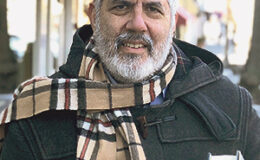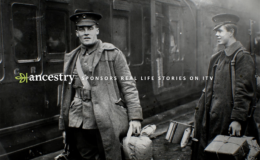
Ryan Kramer is used to making spreadsheets. He graduated from high school at age 14, received an undergraduate degree in aerospace engineering at 18, and a master’s in engineering management at 19. Ten years later, Kramer finds himself making spreadsheets for something other than schoolwork — he uses them to keep track of his 20 half siblings.
Kramer found out he was donor-conceived at a very young age. “I naturally kind of got curious. I came to my mom one day and said, ‘So, did my dad die or what?’”
He set off on a mission to find his sperm-donor dad. Kramer tried everything from sending a letter to the sperm bank at seven years old, to co-founding the Donor Sibling Registry (DSR) with his mom, Wendy, in 2000, which is now the largest matching website for people conceived from donors.
But before finding his donor, Kramer found his first half sibling through the DSR when he was 13. “It was like a mirror looking back,” he said, as he remembered staring at the same teeth and eyebrows in someone he had just met. “It felt like a weight being lifted off my shoulders.”
Now, Kramer says he has to use a spreadsheet to keep track of his growing number of half siblings, which has reached to over 20. Although they may only get together once a year for a reunion, they mostly keep in touch through texting and a Facebook group, named after their donor number.
“When we’re all in a group together, you definitely feel like you’re with your people,” he said. Kramer described having so many half siblings as a “huge blessing” that he “wouldn’t trade for anything.”
More than 16,500 donor-conceived people have connected with their half siblings or their biological parents through the DSR. The largest match between half siblings is around 200, director Wendy Kramer said.
But a sizable half sibling group living within the same geographical vicinity could become problematic. “Most tangibly, there is a potential risk for accidental incest and medical problems that offspring could have unwittingly,” said Dr. Dov Fox, author of Birth Rights and Wrongs: How Medicines and Technology are Remaking Reproduction and the Law.
Last month, Dr. Bryce Cleary filed a $5.25 million lawsuit against a fertility clinic in Oregon after discovering he is the biological father of at least 17 children he did not know about. Cleary said he agreed to be an anonymous donor under the conditions that no more than five children would be conceived and that they would be born to mothers outside the Pacific Northwest. However, many of his 17 offspring were in fact born in Oregon.
The lawsuit says that there was a high chance that some of his children may have attended the same colleges, churches, and interacted within the same social circles without knowing it. Cleary also said he may have unknowingly treated or examined one or more of his offspring while working as a primary care physician in Corvallis, Oregon.
Despite the physical risks, there are also psychological harms at stake for many people conceived of a single donor.
Let our news meet your inbox. The news and stories that matters, delivered weekday mornings.
“It’s understandably overwhelming to learn that they have 10 or 20 or 30 or more half siblings with whom they are at least genetically related,” said Fox. “Some people find comfort in communities like that, but others don’t.”
While Kramer has found a community in his nearly two dozen half siblings, he too believes that there’s a psychological component to being one of many: “A lot of people don’t like the idea of feeling like cattle or part of a herd.”
Kramer is in touch with his donor to this day, describing the relationship not quite like that of a father and son, but rather similar to that of an uncle or a cousin. But a large number of donor-conceived half siblings can hinder the possibility of forming a meaningful connection with respective donors.
“You have a lot of donors who are willing to connect when there’s five kids or seven or 13,” Wendy Kramer said. “When you get up into the very high numbers, it could keep these kids from ever knowing about their ancestry.”
With no national registry among fertility clinics, even if various sperm banks were to keep accurate records for each donor, they would not be able to tell if that person donated to another bank elsewhere in the country.
“We really don’t have a way of keeping track if too many people are in the same area,” said Cory Burke, executive vice president of Cryos International, a sperm and egg bank.
The DSR filed a petition in 2017 calling for a central donor ID database that contains donor social security numbers so that sperm banks across the world can ensure that a donor has not donated sperm at other clinics.
In addition to implementing a regulatory body in the U.S., the petition recommends that donors should be required to regularly update their current medical, genetic and social information in a donor data bank to share with families on command.
“They are sperm sellers. There’s no accountability. There’s no regulation. There’s no oversight. It’s a multibillion-dollar industry,” Wendy Kramer said.
Cryobanks argue that they are heavily regulated by the Food and Drug Administration when it comes to donor health, family history and lab processes. Still, there is no official tally of how many babies have been born as a result of sperm donations in the U.S. With no required tracking or reporting, sperm banks rely on families to self report their pregnancies from donor sperm.
“In the U.S., we have a hard time getting pregnancies reported to us,” said Burke of Cryos International. “The lack of record keeping may be something we can all look at and do better.”
Despite efforts to increase regulation, Dov Fox, a national expert on bioethics and health law, says that the only federal law related to oversight is that fertility clinics are asked to voluntarily report the number of pregnancies from donor sperm to the Centers for Disease Control and Prevention. But in fact, there are no rules or regulations that mandate them to do so.
As a result, donors have no idea how many offspring they have produced or how many offspring they should expect to hear from. And while many sperm banks suggest to families that they limit the number of offspring created from a particular donor, there are no laws officially limiting how many babies can be born from any one donor, as there are in other countries including Hong Kong, Norway, and the United Kingdom.
Jonathan Karpf, 64, is among those donors who doesn’t know exactly how many offspring he has. As a graduate student at the University of California, Berkeley, in the late 1970s, he responded to an advertisement in the local newspaper. While many students chose to donate sperm to make an extra buck, Karpf chose to donate his sperm to help lesbian couples conceive at a time when other donors refused to do so.
Karpf donated 169 times. With a normal success rate of one pregnancy for every three donations, that means he could have at least 56 genetic offspring. As a biological anthropologist who specializes in human genetics, Karpf decided to stop donating on his own, for fear of increasing the odds of possible genetic defects.
“That to me is unconscionable,” Karpf said of the physicians who never told him he was donating too often. “They were more motivated by profit than by the underlying genetic risk of having that many people out there with potential half siblings genetically and wouldn’t know it.”
Wendy Kramer expressed a similar sentiment. Her donor was promised no more than 10 offspring and recently found out about his 20th: “It should be more than just making a buck from selling a vial of sperm. They need to understand that they are creating human beings,” she said. “Profit cannot always come before human ethics.”
Wendy Kramer’s donor and Karpf both donated decades ago and sperm banks claim that the industry has since changed. The Fairfax Cryobank’s current policy is to stop distributing sperm when they have reached 25 families while the maximum goal for California Cryobank is between 25-35 families. Three different sperm banks told NBC News that these limits were implemented between eight to 10 years ago.
“We will stop them well before they ever meet their limit,” Michelle Ottey, the director of operations at Fairfax Cryobank, said. “We, as a field, have really evolved over time. We’ve listened to the feedback that we get from the donor conceived individuals to establish best practices.”
Many donor-conceived children, like Ryan Kramer, might have questions for their donors about where they came from, including information about health and heritage. “I wasn’t looking for money or a commitment or obligation to be a dad,” he said. “Basically, I was just curious about who he was.”
Though sperm banks today often provide photos and the medical history of donors, the common practice is to keep donors anonymous until the offspring turn 18. “Donors are genetically related to these offspring but not family,” Scott Brown, vice president of communications for California Cryobank, said. “Family is what we are in the business of, not genetic connection.”
However, with the emergence of genealogy companies such as Ancestry.com and 23andMe, it has become easier for donor-conceived offspring to find their donors and as a result, more difficult for donors to remain anonymous.
More than 26 million people are finding their genetically related half siblings and donors through sharing their DNA with one of the four leading ancestry and health databases, according to the MIT Technology Review. Ancestry.com and 23andMe are the two major at-home genetic testing businesses, with Ancestry collecting 19 million DNA samples as of Jan. 1, 2019, and 23andMe collecting 9 million samples.
“Pandora’s box has been open,” Burke of Cryos International said.“Now they [donors] have people knocking on their doors, like ‘Hey, Dad?’”














